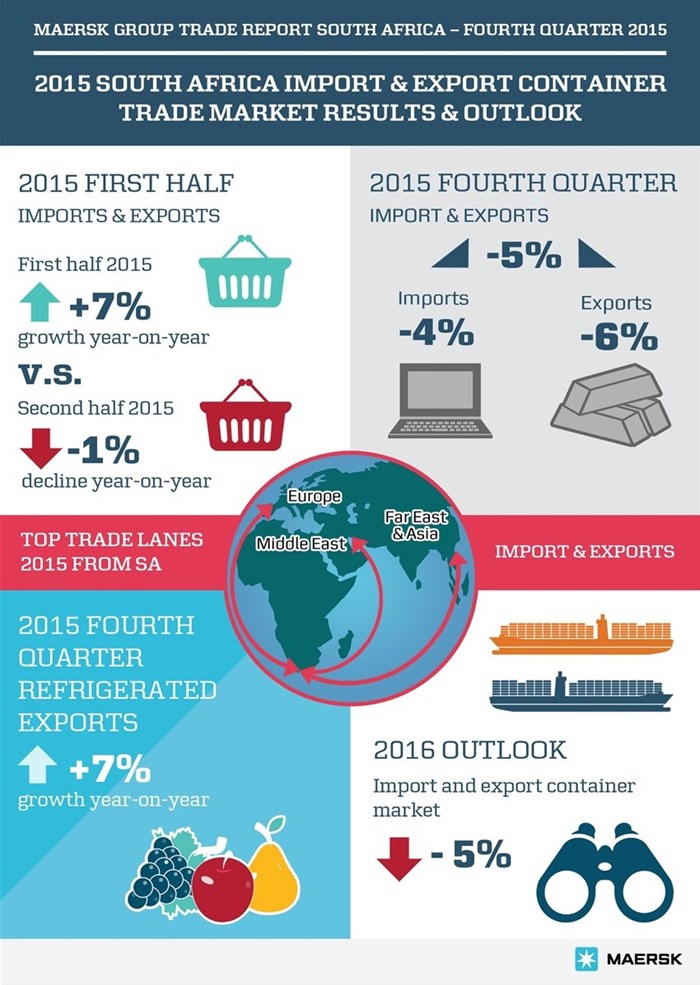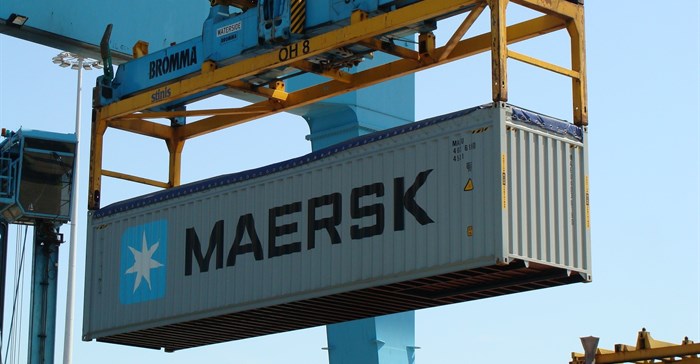
Top stories

Marketing & MediaShaping conversations and driving impact: Radebe Merci reflects on media influence in 2025
MDNTV 1 hour


Marketing & MediaHoliday entertainment made simpler for DStv subscribers this festive season
MultiChoice 48 minutes




Q4 Maersk Trade Report Infographic
The sharp decline during the fourth quarter of 2015 is not isolated to one sector or trade direction, says Jonathan Horn, managing director of Maersk Line Southern Africa, a member of Maersk Group, with both import (4%) and export (6%) markets declining.
He explains that the Asian import market, in particular, was down by 9%, which is a sign that that the weaker Rand and lower consumer confidence is, in fact, weakening import demand. “The majority of the imports from Asia, which represents about 55% of South Africa’s total import market, include retail, electronics and overall consumer goods, and are thus highly susceptible to available consumer spend, which has been on the decline.”
Horn says that the export market predominately consists of commodities including chrome, manganese, scrap metal and copper, which are the backbone and driving force of South Africa and many economies in Africa. He explains that with the recent drop in global demand, mostly due to China’s slowing economy, the African continent has been hit hard. In particular, there has been a significant drop in manganese exported from South Africa.
“Despite the drop in commodity prices, many countries around the world are still dependent on Africa’s resources. China, for example, depends on Angola for oil and on Zambia for copper, and although the rate at which the country imports these commodities will slow, the need will remain,” says Horn.
Trade Manager at Maersk Line Southern Africa, Matthew Conroy, stresses that these industries will, however, need to remain forward-thinking and explore innovative ways to increase the trade levels of resources with developed nations. “This can be achieved by improving access to trade in Africa, particularly in landlocked countries such as Malawi, Zimbabwe and Zambia, through improved infrastructure and customs procedures.
The formation of the World Trade Organization’s (WTO) landmark Trade Facilitation Agreement (TFA), which will leverage business expertise and resources in the implementation of customs and border reforms, will also contribute positively towards improving intra-African trade. Further, a collaboration with regional partner countries is being stepped up to improve border management, streamline trade flows and invest in transport and communications corridors, according to information recently released in the national Budget Speech.
“Moreover, the need for more refinement of commodities has never been greater. Rather than outsourcing raw commodities to other countries, South Africa and the rest of the African continent should look to capitalise on its commodities.”
According to Conroy, exports are not expected to rebound in the first half of 2016 as global demand for mineral commodities – particularly from China – is expected to be flat. He says that the low prices are making some mines, and similarly the container market, unprofitable, forcing mines to curtail production.
“We do not expect to see significant container market growth in 2016, and it is likely that the declining trend recorded during the fourth quarter will continue into the first half of 2016. As the Rand remains volatile, imported goods will remain expensive to South African consumers who already have less money to spend.”

Dirk Hoffmann, managing director at Safmarine in Southern Africa, a member of Maersk Group, says that based on the weakening Rand, the export of manufactured goods remains the biggest opportunity for South Africa and the container market. “The refrigerated export market continued to see robust growth of approximately 7% in 2015, which is attributed to strong crop output of apples, pears, grapes and citrus during the year, with grapes showing the strongest growth relative to a poor 2014, coupled with stronger prices in Europe.”
Hoffmann says it was expected that the local fruit market would grow in 2016, but with the drought and excessive heat, the fruit industry is likely to see less exports over the next 12 months. “The impact will vary widely based on geography, but the Western and Northern Cape are likely to be the hardest hit. Although it is expected that almost all fruit types will be negatively impacted by the drought, the full impact will only be determined in coming months when the fruit is picked.”
He says that the export vehicle market is currently stable, however as consumer spend is expected to be lower in 2016, it is predicted this will negatively impact vehicle demand in South Africa. “The industry will need some form of relief, so the R20 billion investment into the sector, which was announced at the national Budget Speech, will assist greatly in this regard.” He adds that the biggest container growth opportunity in the vehicle segment is within Africa as a result of countries like Nigeria purchasing more from South Africa.
According to Hoffmann, when it comes to volume, the top import trade lanes from South Africa in 2015 were the Far East and Asia, consisting mainly of vehicles, textiles, apparel and electronic goods; Europe, mostly made up of vehicles, machinery and electronic goods; and the Middle East, which consisted of plastic and rubber, textiles and cereals such as rice, seeds and beans.
He says that the top export trade lanes during 2015 include the Far East & Asia (ore, metal and wood such as paper pulp) Europe (refrigerated cargo, vehicles and food and beverages such as wine) and the Middle East (metal, refrigerated cargo and ore).
“Overall, the 2016 container market is facing numerous economic obstacles and, therefore, growth is not expected. Rather, it is anticipated that the import and export container market will contract by about 5% during the first quarter. Although challenging, the current economic climate does offer exporting opportunities, which various sectors should try and capitalise on,” says Hoffmann.